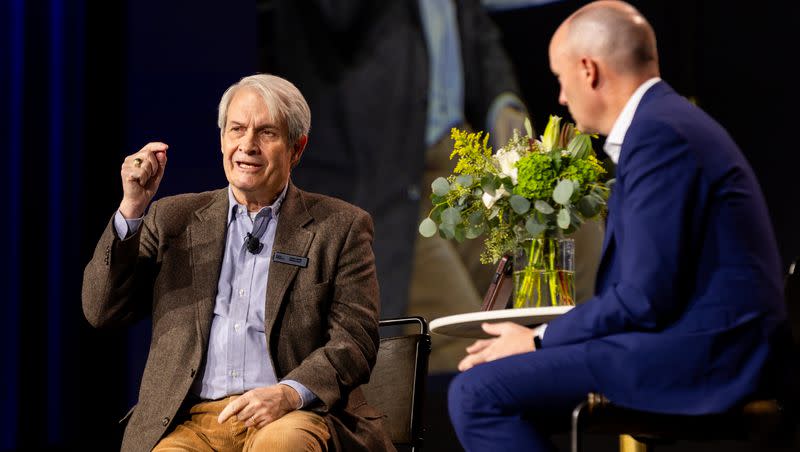Two U.S. Supreme Court Justices on how they ‘disagree better’

- Oops!Something went wrong.Please try again later.
- Oops!Something went wrong.Please try again later.
Did you know the Supreme Court justices eat lunch together regularly?
Former U.S. Court of Appeals Judge and Wheatley Institute constitutional government fellow Thomas B. Griffith joined U.S. Supreme Court Justices Sonia Sotomayor and Amy Coney Barrett on the stage Friday in Washington, D.C., to moderate a conversation between the justices about their experiences with collegiality and civil disagreement.
The conversation happened as part of the National Governors Association conference. Utah Gov. Spencer Cox, the current chair of the association, has spent the conference hosting conversations around his “Disagree Better” campaign.
When Griffith asked how important collegiality is to the court, Sotomayor brought up the Noah Feldman’s book “Scorpion.” The book describes a time where there was “open animosity among the justices, they publicly excoriated each other,” she said.
“Even though they were appointed by the same president,” Barrett added.
Something changed when the late Justice Sandra Day O’Connor joined the court, Sotomayor said. “She was renowned for being a politician who got things done and she got things done by bringing together both sides of the aisle.”
O’Connor insisted on justices eating lunch together and getting to know each, Sotomayor said. Since then, Supreme Court justices including Sotomayor and Barrett have continued some of these traditions to create a “culture of collegiality” — to borrow a phrase from Griffith.
“The lunch is a routine of the court,” Barrett said. “Our schedule is roughly two weeks of oral arguments a month and the other two weeks is writing opinions and preparing to start over again the next month. Those two weeks we are in session, we have lunch together four times a week, after arguments and after the Friday conference. That is a lot of time together.”
The night of Barrett’s confirmation vote when she was at the White House, she said the first call she received was from Sotomayor congratulating her.
Sotomayor shared some advice that Justice David Souter gave her.
“He welcomed me and said, ‘Sonia, I know life on the court became easier for me when I had an epiphany one day. And that was I get very upset and angry as a dissenter because I couldn’t convince my colleagues of my views. It drove me crazy,’” Sotomayor related. “And he said ‘at a certain point I realized, they are as passionate about the Constitution, about our laws, about our democracy as I am.’”
This had a significant impact on Sotomayor who said people who enter public service often have the same core values even if there’s disagreement.
Related
The Supreme Court is full of friendships that cross party lines.
“Neil Gorsuch and I speak together as I do with Justice Barrett on civic issues with a variety of different audiences. It’s not as if we are not spending time together. We do,” Sotomayor said. “We have dinners with virtually all my colleagues. I try to invite all of them to my home when they join the court. That’s part of my way of welcoming them.”
Shortly after Barrett joined the court, she recalled when Sotomayor showed up to her office with Halloween candy for her kids. She was the recipient of other kind gestures. “The first year I was on the court, I was living here and commuting back home when I could and many colleagues had me over for meals to make sure I wasn’t by myself in the evening and just to get to know me.”
Both Sotomayor and Barrett expressed that their principles have remained the same, but these friendships they’ve created have fostered understanding.
“I think the time spent together goes a long way toward knowing one another as people and I think collegiality isn’t going to make you change your principles,” Barrett said.
Inside the courtroom, the justices also work to maintain civility.
During oral arguments, there are certain procedures followed including if two justices want to ask questions at the same, they proceed in order of seniority. “We each also try to keep an eye on our time so none of us in monopolizing the floor too much,” Barrett said.
When there isn’t room for shifting an opinion, Barrett said the justices still try to make room for compromise. “We don’t sausage make what we think the Constitution requires. It’s not give a little or get a little on a bill, but we can compromise on how we present things, how narrowly or broadly we write them, whether we’re willing to let certain arguments drop out and not do things just because you can or just because you have the pen.”

